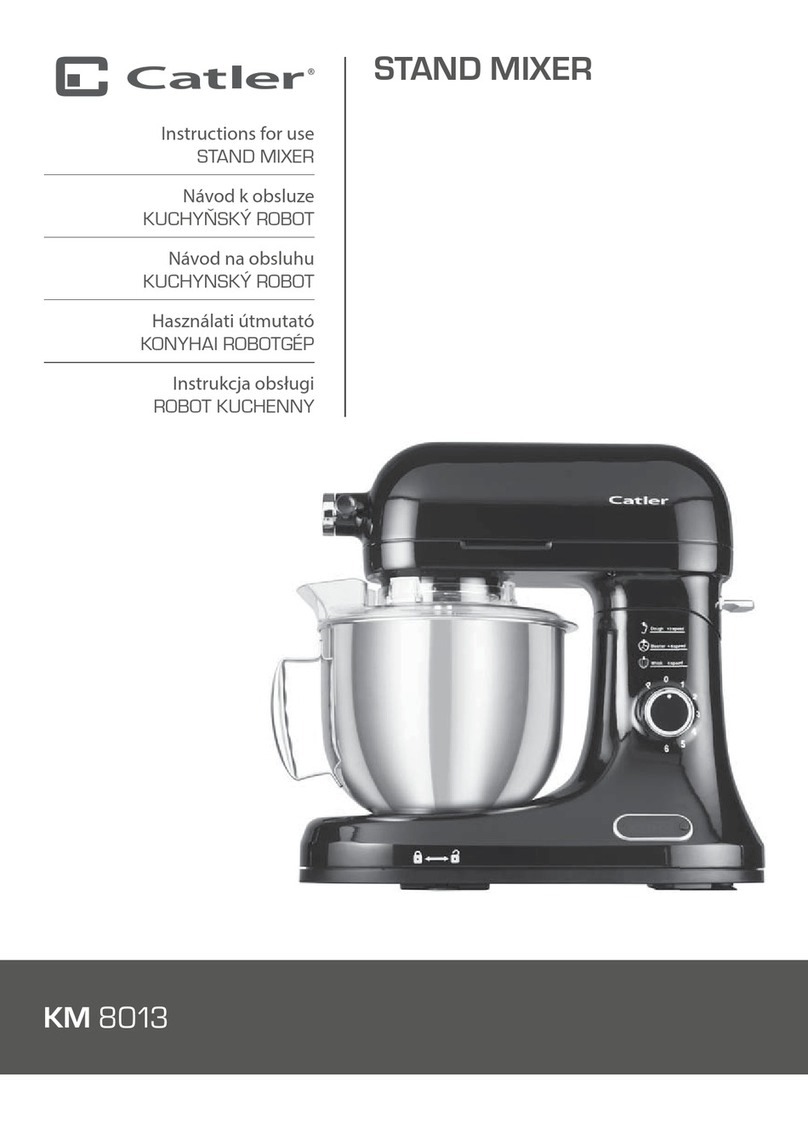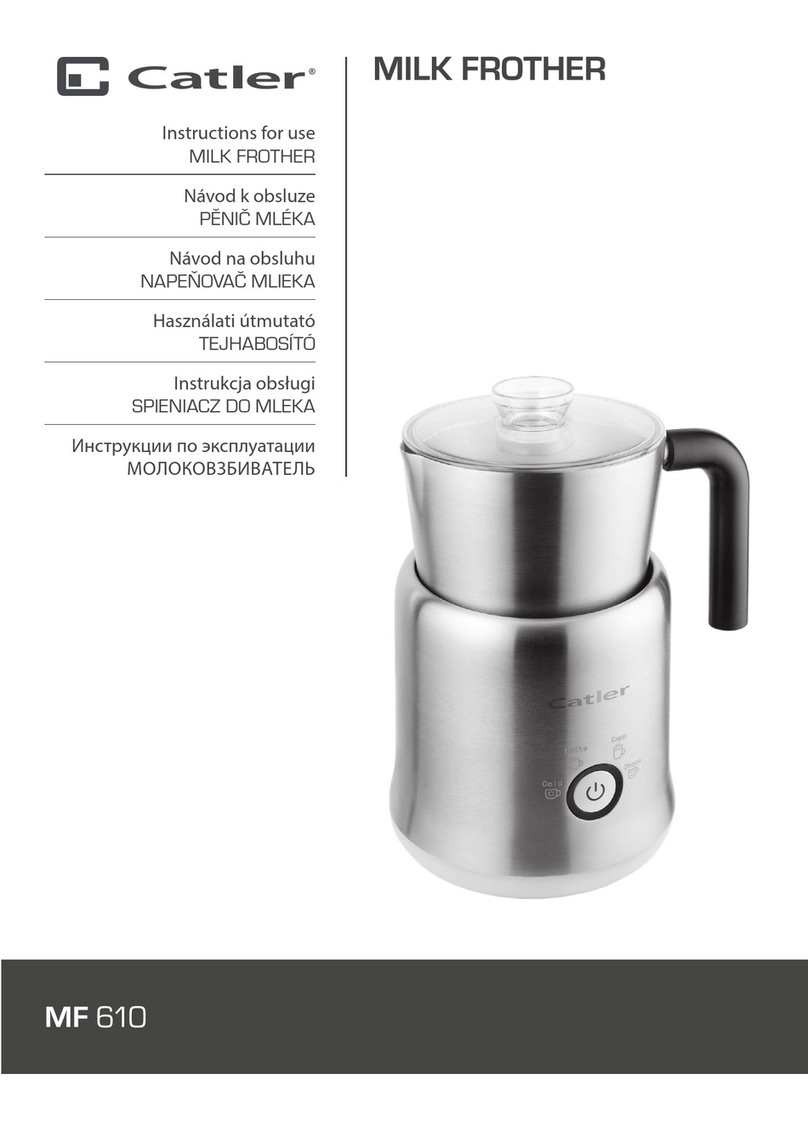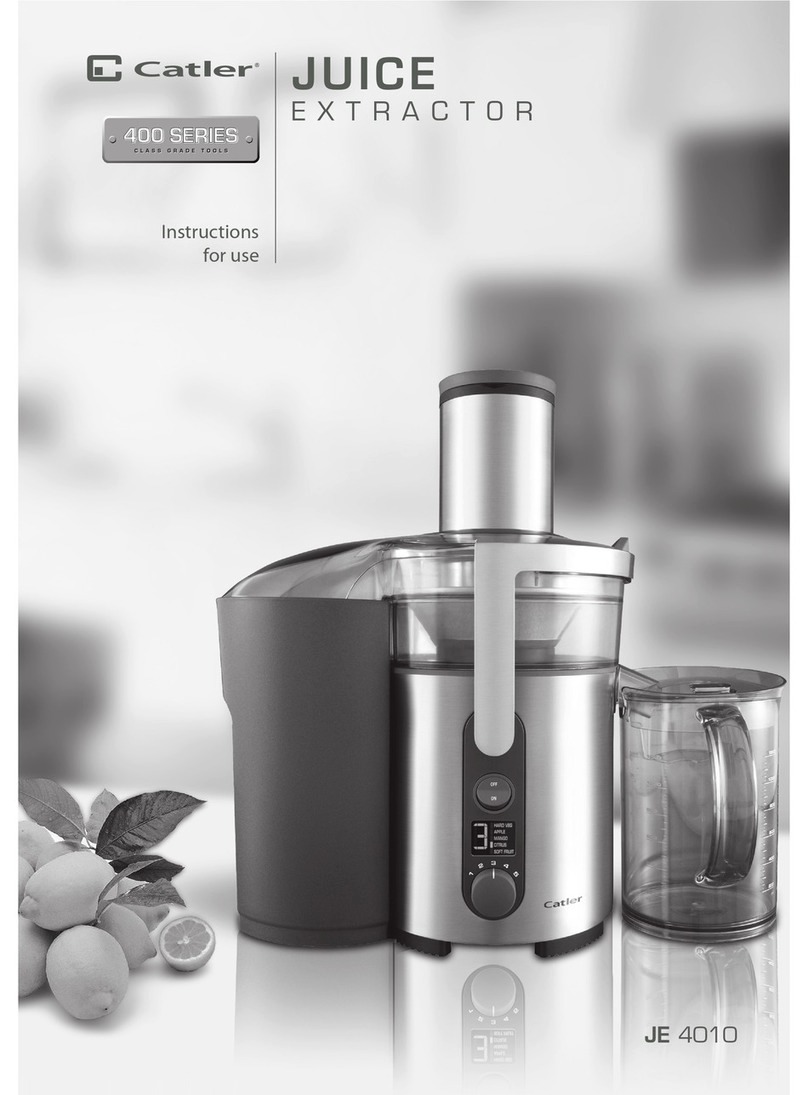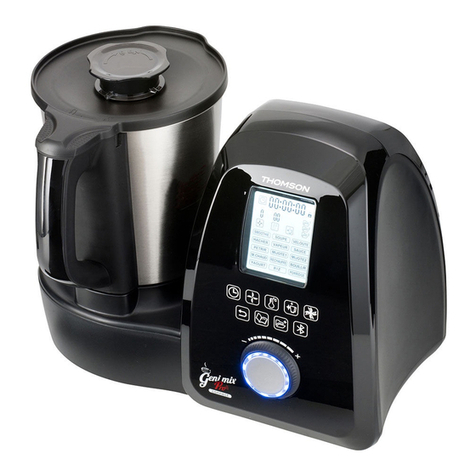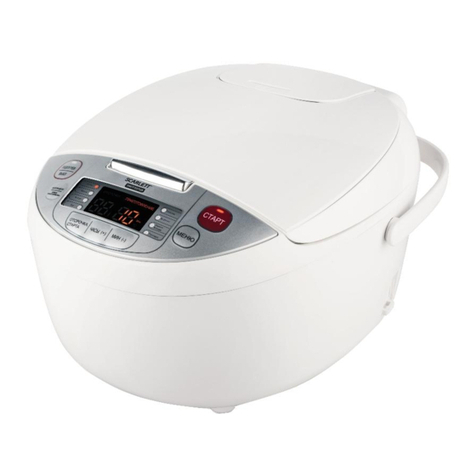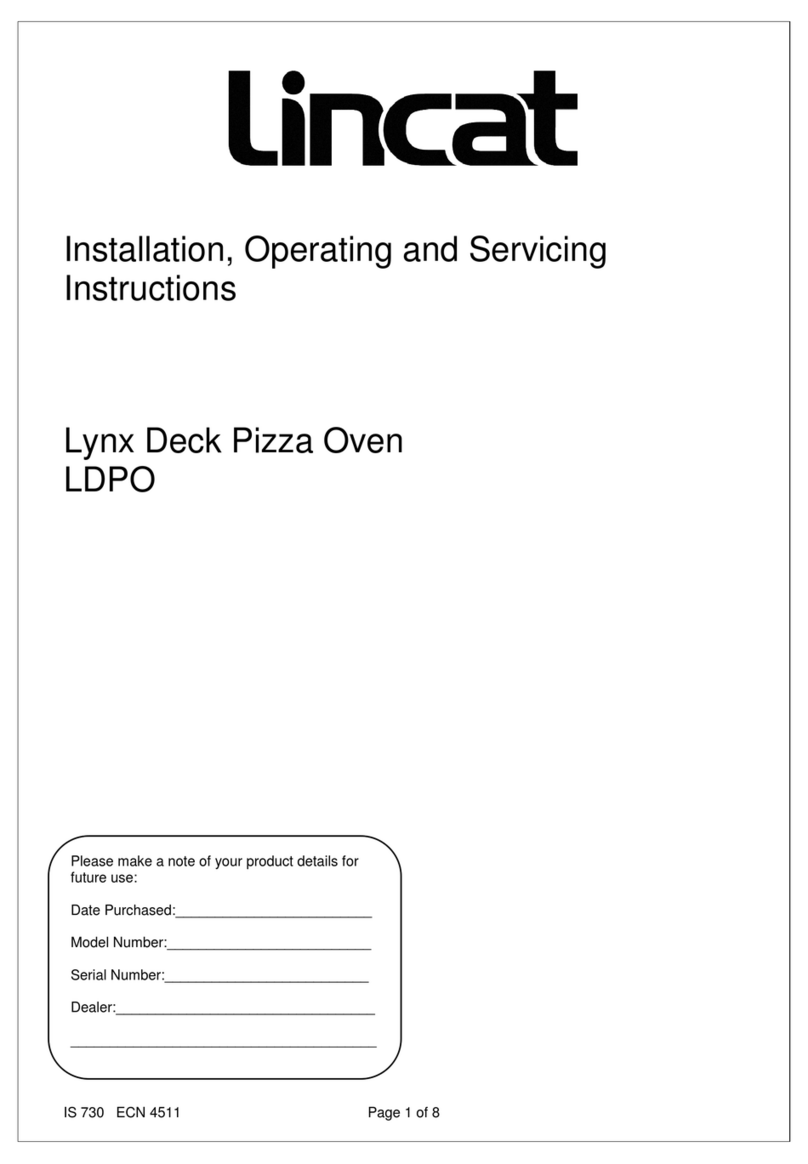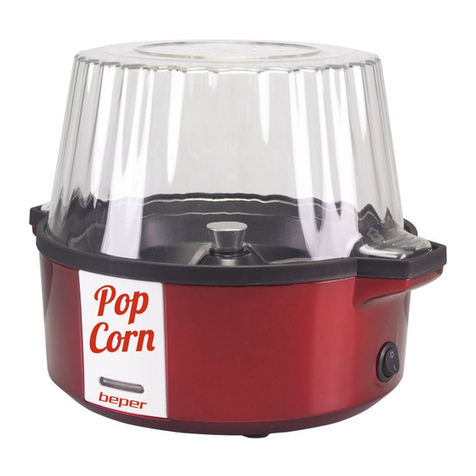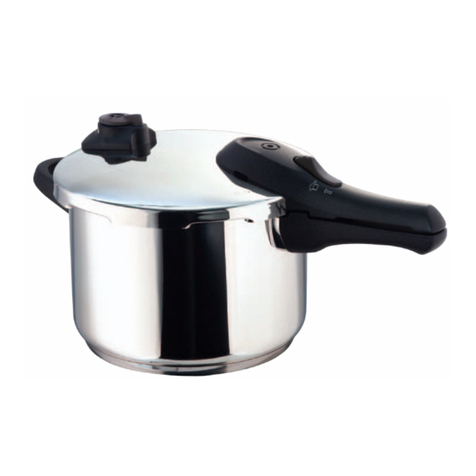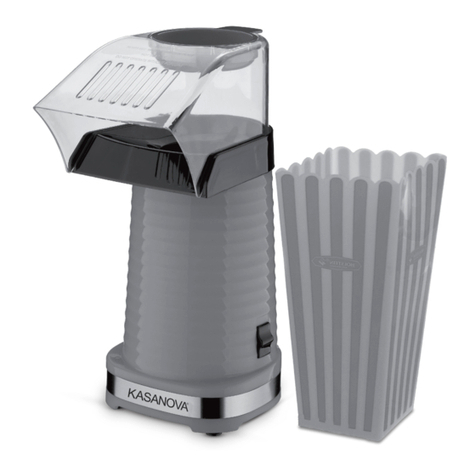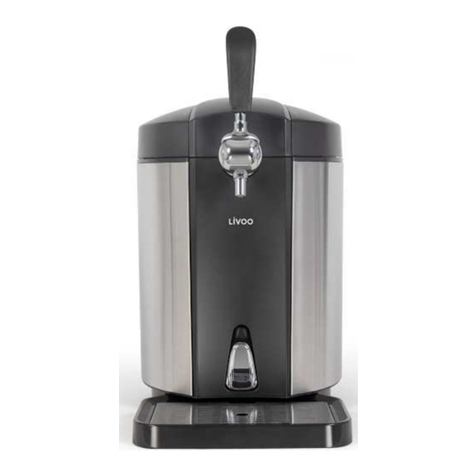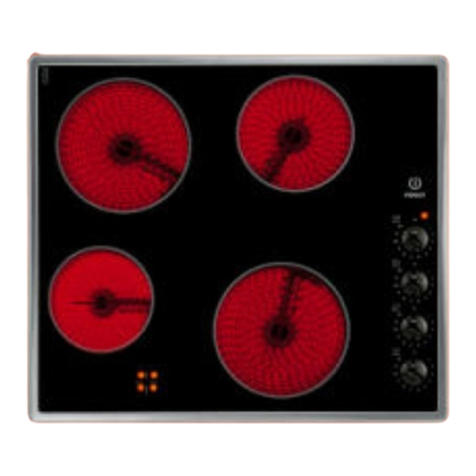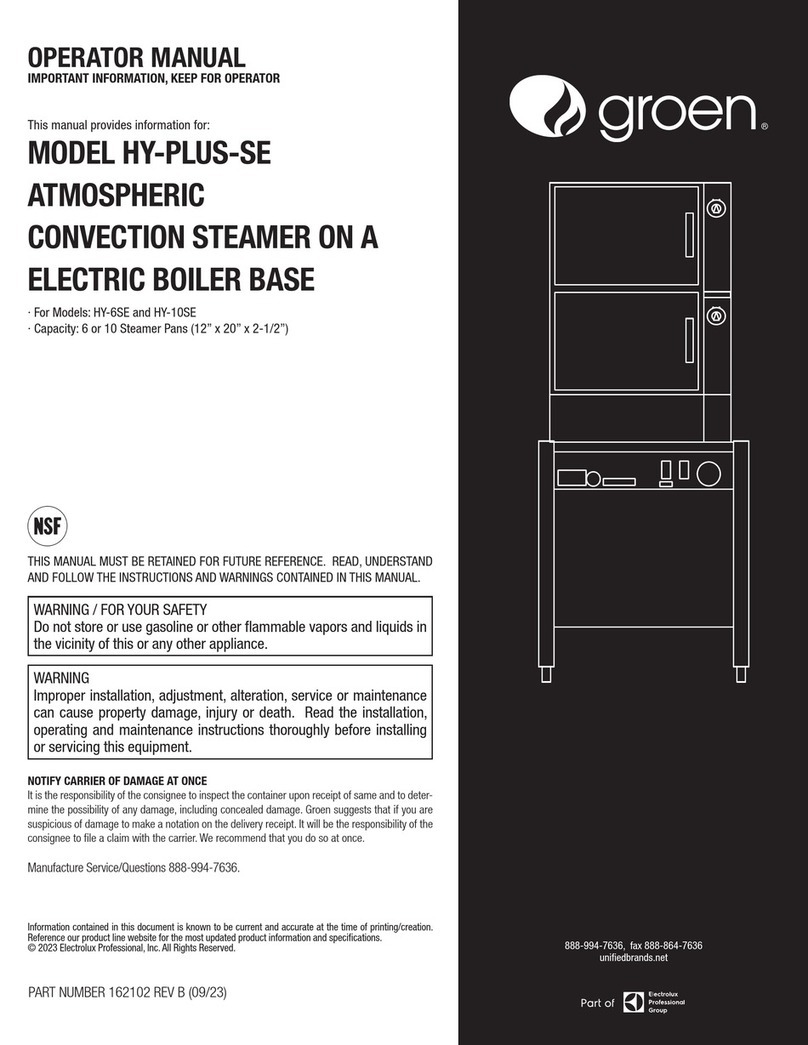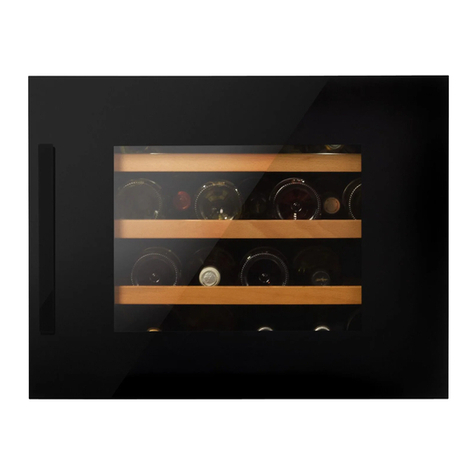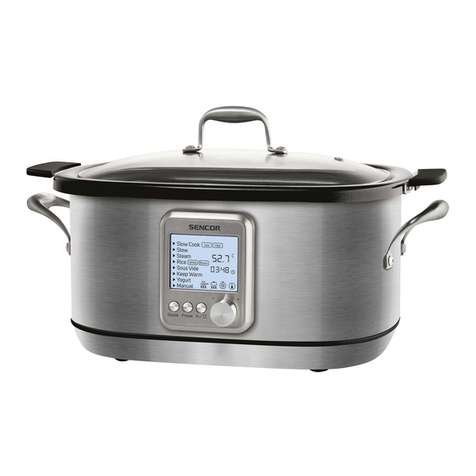Catler FD 4010 User manual

FOOD DEHYDRATOR
FD 4010
Instruction Manual
FOOD DEHYDRATOR
Návod kobsluze
SUŠIČKA POTRAVIN
Návod na obsluhu
SUŠIČKA POTRAVÍN
Használati útmutató
ÉLELMISZER SZÁRÍTÓ
Instrukcja obsługi
SUSZARKA SPOŻYWCZA
Руководство по эксплуатации
ДЕГИДРАТОР ДЛЯ
ПРОДУКТОВ

FOOD
DEHYDRATOR

1
TABLE OF CONTENTS
FOOD
DEHYDRATOR
TABLE OF CONTENTS
2 Catler recommends safety rst
5 Know your FD 4010 dehydrator
7 Features of your FD4010 dehydrator
8 Operating your FD 4010 dehydrator
8 Before rst use
8 Using your dehydrator
9 Automatic mode
9 Manual mode
9 Tips for proper dehydrating
12 Overview of foods and recommended
dehydration times
13 Care and cleaning

2CATLER RECOMMENDS SAFETY FIRST
CATLER RECOMMENDS SAFETY FIRST
We understand the importance of safety and that’swhy we put your safety rst from the
initial design concept to the production itself. Nevertheless, please be careful and follow the
instructions below when using this appliance.
• This appliance may be used by children 8 years
of age and older and by persons with physical
or mental impairments or by inexperienced
persons, if they are properly supervised or
have been informed about how to use of the
product in asafe manner and understand the
potential dangers.
• Children must not play with the appliance.
Cleaning and maintenance performed by the
user must not be performed by children unless
they are older that 8 years of age and under
supervision.
• If the power cord is damaged, ask the
authorised service for areplacement in order
to prevent hazards. It is forbidden to use the
appliance with the power cord damaged.
• Children under 8 years of age must be kept
away from the appliance and its power cord.
• Always clean the appliance parts that come
into contact with food in accordance with the
instructions in this manual.

3
CATLER RECOMMENDS SAFETY FIRST
• This appliance is not designed to be controlled
using aprogramming device, external timer
switch or remote control.
• Before connecting this appliance to apower socket, make sure the voltage stated on the
product'srating label corresponds to the voltage in your power socket.
• Use only power cord supplied with the appliance.
• Do not disconnect the appliance from the power socket by pulling the power cord. This
could damage the power cord or the power socket. Disconnect the cord from the power
socket by pulling the plug.
• Do not connect or disconnect the appliance power cord to or from the power socket with
wet hands.
• Keep the power cord dry. Never use the appliance in the near vicinity of abath, shower or
swimming pool.
• Do not connect or disconnect the power cord to or from the power socket with wet hands.
• To prevent possible electric shock, do not expose the appliance or its power cord to
dripping or splashing water, or immerse it in water or other liquids.
• Do not use the appliance if it is not working correctly, if it has been damaged or has been
immersed in water.
• Always switch o the appliance and unplug it after use.
• The appliance is equipped with asafety mechanism that interrupts its operation if the
door is opened. When the door is closed, the operation will be restored. If operation is not
interrupted after opening the door, switch o the appliance, disconnect the mains plug
from the mains socket and contact an authorized service centre.
• This appliance is designed for use in households, oces and similar types of areas. Do
not use it in an industrial environment, outdoors or in rooms with high humidity, such as
laundry or bathrooms.
• Do not use the appliance for purposes other than food dehydration.
• Do not use the appliance to dehydrate liquids or food that may turn into apowder and
ignite. Do not insert glass, metals or other similar materials into the appliance.
• Only use the appliance with original accessories from the manufacturer. Never use
accessories, which have not been supplied with this appliance or which have not been
explicitly recommended by the manufacturer.
• Do not expose the appliance to direct sunlight or place it near naked ames or appliances
that generate heat, such as electric and gas cookers.
• Only place the appliance on aclean, dry, at and stable surface. Do not place the
appliance on the edge of akitchen worktop or table top or use it on the sink drip tray.
Also, do not place the appliance on window sills. Always leave aspace of at least 15cm
around the appliance.
• Do not place any objects on the appliance. Do not climb or sit on it.
• Protect the appliance and accessories from falling to the ground or on atable, even from
asmall height, and from objects falling on them.
• Do not insert any objects into the appliance ventilation openings. Do not cover the
ventilation openings of the appliance, there is arisk of overheating.

4CATLER RECOMMENDS SAFETY FIRST
• Do not handle the appliance while it’sin operation.
• Keep children and pets away when the appliance is in use.
• Never leave the appliance in operation without supervision. Keep control over the
appliance throughout the food dehydration.
• Do not use sprays in the vicinity of the appliance.
• Do not insert any paper or plastic materials in the appliance interior. Do not store any
items in the appliance interior.
• Be careful when handling the appliance, grilles and tray, they may be hot!
• The temperature of accessible surfaces may be higher if the appliance is in operation. Do
not touch hot surfaces. Do not carry the appliance while it’shot.
• Always turn o and unplug the appliance when not in use and when left unattended,
before inserting or removing the grilles and tray and before cleaning or moving it. Always
allow the appliance to cool down properly.
• Keep the grilles and tray clean as they come into direct contact with food.
• Never wash the appliance under running water or immerse it in water or another liquid.
Except for grilles and trays, no part of the appliance is dishwasher safe.
IMPORTANT SAFETY INSTRUCTIONS FOR USING ELECTRICAL EQUIPMENT
• Fully unwind the power cord before use. Connect the appliance only to aproperly
grounded socket.
• Do not leave the power cord hanging over the edge of atable or countertop or allow it to
touch ahot surface or to become tangled up.
• For safety reasons, we recommend to connect the appliance in an independent electrical
circuit separated from other appliances. Do not use adapter plugs or extension cords to
connect the appliance to apower outlet.
• Do not use this appliance in moving vehicles or on boats, outdoors, or for any purpose
other than intended. Otherwise, there is arisk of personal injury.
• Any maintenance other than standard cleaning must be performed at authorised
Catler service centre. To avoid the risk of electric shock, do not repair and/or make any
adjustments to the appliance by yourselves.
• We recommend to install aresidual current device (standard safety switches in your power
outlet) to provide ahigher level of protection when using the appliance. We recommend
to install aresidual current device (with anominal residual operating current of no more
than 30mA) in the electric circuit in which your appliance is to be connected. For further
expert advise, please contact your electrician.
The user’smanual is also available at www.catler.eu.

5
KNOW YOUR FD 4010 DEHYDRATOR
KNOW YOUR FD 4010 DEHYDRATOR
1. Control panel
2. Door
3. Door window
4. Handle
5. Grille (5pcs in the package)
6. Tray
No illustration
Ventilation openings - they are positioned at the rear
of the dehydrator.
Detachable power cord
1
2
3
4
TIME/TEMP
IR/NRM
ON/OFF
5
TIME/TEMP
IR/NRM
ON/OFF
6
TIME/TEMP
IR/NRM
ON/OFF

6KNOW YOUR FD 4010 DEHYDRATOR
CONTROL PANEL
TIME/TEMP
IR/NRM
ON/OFF
1 2 3 4 5
1. Button + - used to set the temperature, time of dehydration or to select the operating
mode.
2. Button- - used to set the temperature, time of dehydration or to select the operating
mode.
3. Display - displays the set temperature, time of dehydration, operating mode, operating
and error messages.
4. TIME/TEMP/IR/NRM button - used to select individual functions of the dehydrator.
5. ON/OFF button - used to turn the dehydrator on or o and start the dehydrating process.

7
FEATURES OF YOUR FD4010 DEHYDRATOR
FEATURES OF YOUR FD4010 DEHYDRATOR
ABREAKTHROUGH FOOD DEHYDRATING
METHOD
The Catler FD 4010 food dehydrator comes
with the latest innovative method of food
dehydration. It uses both acompletely
new solar method of food dehydration and
aclassic method of food dehydration with
hot air.
The solar dehydrating method uses the
so-called NIR technology ("Near Infrared"
technology), where the emitter rays have
the same eect as the sun'srays and can
penetrate deeper into the food. This shortens
the time of dehydration, which contributes
to the preservation of important minerals
and vitamins, such as vitamin C or D, which
are very sensitive to heat and heat treatment.
Thanks to this method, you will be able to
prepare your own dried tomatoes, dried
beef or delicious vegetable chips, with just
alittle solar heat, which can also preserve the
structure and taste of dehydrated food.
This method is suitable for dehydrating food
where it’simportant to precisely control
the temperature and air circulation. It is
therefore ideal for raw foods. Thanks to the
improved temperature control system, it can
be controlled and kept even throughout the
dehydrating process.
INNOVATIVE DESIGN
The Catler FD 4010 food dehydrator comes
not only with revolutionary technology,
but also with an innovative modern design.
As one of the rst fruit dehydrators in the
world, it comes up with two methods of
food dehydration: the solar method and
the classic dehydrating method. It is made
of high quality and durable materials with
stainless steel grilles and afood drying tray
that is easy and quick to clean to ensure
maximum hygiene. Thanks to the integrated
external appearance, which resembles
abaking oven, and the design of the interior
space, heat is perfectly distributed and air is
circulated.
PRESERVATION OF MINERALS AND
VITAMINS
Thanks to intelligent dehydrating methods,
you can store dried food without worrying
about harmful ingredients. Dehydration
is agreat way to store nutrients in food
naturally. Only 3-4% of nutrients are lost
during the proper dehydrating process,
and that'swhat the Catler FD 4010 food
dehydrator oers. The correct dehydrating
process is when the food is exposed to
alower temperature, which does not destroy
important nutrients. And thanks to the
solar method, you can store more C and D
vitamins in your food.

8OPERATING YOUR FD 4010 DEHYDRATOR
OPERATING YOUR FD 4010 DEHYDRATOR
BEFORE FIRST USE
Before rst use, remove all packaging
and advertising labels / stickers from the
appliance.
Check the packaging material before
disposing for any accessories in the recesses.
Wipe the dehydrator outer surface with a soft
sponge slightly moistened in warm water,
then wipe dry with a clean cloth.
Remove the grilles and tray and wash them
in warm water with a small amount of
washing-up liquid. Rinse in clean water and
wipe dry with a clean cloth.
USING YOUR DEHYDRATOR
1. Place the dehydrator on a at and dry
surface. Make sure to leave a sucient
clearance around the dehydrator to allow
proper air circulation around it.
2. Stack the food you want to dry on the
grilles or tray.
3. Open the door and insert the grilles and
tray inside. Close the door.
4. Insert the power cord terminal in the
socket at the rear of the dehydrator, then
plug the power cord in the mains socket.
An acoustic signal will sound and the
dehydrator will switch into standby.
5. Press ON/OFF and select the operating
mode: automatic or manual: - see the
manual below. Wait about 10 seconds
and the dehydrating process will start.
6. As soon as the dehydrating process is
nished, an acoustic signal will be made
and the display will show "END". The
dehydrator will then be switched into the
standby mode and all light indicators will
go out. Press the ON/OFF button to turn
the dehydrator o.
7. If you open the door during the
dehydrating process, the dehydrator
operation will be paused. The display
will show“E1”(door is open). Only the
fan will remain running. If you close the
door within 2 minutes, the dehydrator
operation will be restored automatically.
However, if you don’t close the door
within 2 minutes, the dehydrator
operation will stop and the dehydrator
will switch into standby. If you want to
continue with dehydrating, it’s necessary
to make the settings again.
8. Unplug the power cord from the mains
socket. If you are going not to use the
dehydrator any more, unplug the power
cord from the rear socket.
9. Open the door carefully to avoid scalding
from the escaping steam that may form
during the dehydrating process. This is
normal.
10. With the protective kitchen gloves
attached, remove the grilles or tray and
place them on a metal grid to allow the
dried food to cool.
11. Transfer the dried foods into glass
containers and store them in cold and
dry environment.
12. Clean the grills and tray according to the
instructions in the “Care and Cleaning”
chapter.
NOTE
Before using the dehydrator again,
always clean the grilles and tray
according to the instructions in
the "Care and cleaning" section
and let it cool down for about 30
minutes, especially if you have set the
temperature above 50°C.

9
OPERATING YOUR FD 4010 DEHYDRATOR
WARNING!
Before inserting
the grilles and trays
in the dehydrator,
make sure that they
are clean and dry.
Never operate the
dehydrator without
the grilles or tray
inserted.
AUTOMATIC MODE
In the automatic mode, temperature,
dehydrating time and method will be
set automatically. Thanks to the sensors
measuring the humidity in the dehydrator
interior, the dehydrating process ends when
the humidity level has reached 3% or less.
1.
Turn the dehydrator on by pressing ON/
OFF. This will enable the automatic mode:
• Preset temperature: 50°C;
• Preset drying time: 10:00
• Drying method: NRM (normal = usual
dehydrating method)
2. Wait about 10 seconds and the
dehydrating process will start.
NOTE
To change the dehydrating method,
press TIME/TEMP/IR/NRM briey 3
times in a row. Then press +/- to select
the dehydrating method: IR (solar
method) or NRM (normal dehydrating
method).
MANUAL MODE
In manual mode, you have absolute control
over the set temperature, dehydrating time
and method. Depending on the dierent
foods and their humidity, you can adjust the
settings to your own taste.
1. Turn the dehydrator on by pressing ON/
OFF.
2. Press TIME/TEMP/IR/NRM once briey
and the display will show a temperature
of 50°C. Press +/- to select dehydrating
temperature from 35 to 75°C in 5°
steps. The temperature will be stored in
memory in about 5 seconds.
3. Press again TIME/TEMP/IR/NRM briey
and the display will show a dehydrating
time of 10:00. The “10” value will start
ashing. Use the +/ buttons to set the
hours. Press TIME/TEMP/IR/NRM shortly
and the minute value will start ashing.
Use the +/- buttons to set the minutes.
The drying time can be set in the range
from 00:10 to 48:50. The drying time will
be stored in memory in about 5 minutes.
4. Press again TIME/TEMP/IR/NRM briey
and the display will show the NRM
dehydrating method (normal method).
Press +/- to select the dehydrating
method: IR (solar method) or NRM
(normal dehydrating method).
5. Wait about 10 seconds or press ON/OFF
to start the drying process. The display
will alternately show temperature and
time.
TIPS FOR PROPER DEHYDRATING
In this section you will nd some tips for
proper dehydrating of fruits, vegetables, nuts
or spices.
We recommend to observe the following:
• Dehydrate ripe fruits or vegetables in
the usual harvest period, or buy fruits or
vegetables from local sources, directly
from farmers, etc.

10 OPERATING YOUR FD 4010 DEHYDRATOR
• Dehydrate fruit or vegetables of
adequate maturity. Overripe fruits
or vegetables are not suitable for
dehydrating.
• Remove parts that are not suitable for
dehydrating, such as stems, stalks, pits,
seeds, peel, etc. Peel fruits or vegetables
as needed.
• Cut the food into same-sized pieces. This
will ensure that all foods are dehydrated
simultaneously with the same quality.
• When dehydrating spicy foods (e.g. with
barbecue sauce or salted meat), coat
them with olive oil, marinade or honey
so that the spices penetrate into the food
structure.
• Store the processed foods in glass
containers.
If the foods are dehydrated excessively, place
them in a glass container and add a slightly
moistened paper towel and a sheet of lettuce
or spray some water on the dehydrated food.
FRUIT
• Dehydrated fruit is a great healthy snack
on trips, camping or just watching TV
instead of salty potato chips.
• For the best results, use crunchy fruits
(such as apples), but not much overripe
fruits.
• During the dehydrating process, there is
a natural loss of sweet taste, especially for
bananas. After slicing, you can sprinkle
slices of banana or other fruit with spices
such as cinnamon, nutmeg or vanilla,
or sweeteners such as agave, stevia or
maple syrup.
• Be sure to remove pits, kernels, seeds
and other parts that are not suitable for
dehydrating.
VEGETABLES
• Dried vegetables, such as carrots, corn,
zucchini or mushrooms, are a great base
for soups all year round or on a camping
holiday.
• Cut the vegetables into the same-sized
pieces.
• Peel vegetables, remove seeds, stalks
and other parts that are not suitable for
dehydrating.
• By dehydrating, some vegetables
enhance their taste, such as onions, while
others sweeten, such as carrots.
CEREALS
• Before dehydrating, the cereals should be
soaked in water for 2-3 days.
• Let the grains germinate, then dehydrate
them and grind our from the dried
sprouted grains, which will be rich in
nutrients and minerals.
• You can prepare spicy crackers, sweet
biscuits or even bread from a mixture
of cereals, spices, herbs, vegetables or
dried fruit. Try dierent ratios to get the
optimal results according to your taste.
NUTS
• The nuts must be soaked in water before
dehydrating. It’s important for all the
nuts to be immersed in water. Add some
hydrogen peroxide and leave on for
about 5 minutes, then rinse thoroughly.
This will remove unwanted mold germs.
• Soft nuts, such as cashew nuts or pecans,
require only a short soak. On the other
hand, hard nuts, such as almonds or
Brazil nuts, require a longer soaking
time (about 6-12 hours). However, add
hydrogen peroxide at the very end of
soaking, for about 5 minutes.
• Dried soaked nuts stay fresh for a longer
period of time, in addition, they are free
of unwanted germs, which can cause
health problems in sensitive individuals.
The dehydrating time of such nuts can
be up to 48 hours, depending on the

11
OPERATING YOUR FD 4010 DEHYDRATOR
type, size, length of soaking and ambient
humidity.
• Dried soaked nuts can be ground and
used as an alternative to regular wheat or
rye our.
SEEDS
• Soak the seeds in cold water to remove
the coating that protects them from
automatic germination. However, some
seeds germinate very easily, such as
sunower seeds.
• If you want to grind our from seeds, you
need to soak them, then dry.
• Mix soaked seeds with other foods
(vegetables, fruits, nuts or cereals). They
work well as a thickener and they are very
tasty on top of that.
• You can mix them with cereals or
granules.
SPICES
• If you are about to dehydrate fresh herbs,
remove stems and stalks or other parts
that are not suitable for drying.
• You can dehydrate herbs of one kind
individually or you can combine them
and use as a mixture of spices.

12 OPERATING YOUR FD 4010 DEHYDRATOR
OVERVIEW OF FOODS AND RECOMMENDED DEHYDRATION TIMES
VEGETABLES
Asparagus 5-6 hours Onion 4-8 hours
Beans (green and
yellow)
8-12 hours Parsnip 7-11 hours
Beet 8-12 hours Peas 4-8 hours
Broccoli 10-14 hours Peppers (sweet / hot) 4-8 hours
Cabbage 7-11 hours Popcorn 4-8 hours
Carrot 6-10 hours Potatoes 6-14 hours
Celery 3-10 hours Pumpkin 7-11 hours
Corn 6-10 hours Summer gourd 10-14 hours
Cucumbers 4-8 hours Tomatoes 5-9 hours
Eggplant 4-8 hours Turnip 8-12 hours
Green leaves / tops 3-7 hours Winter gourd 7-11 hours
Mushrooms 3-7 hours Sweet potatoes 7-11 hours
Gumbo 4-8 hours Zucchini 7-11 hours
FRUIT
Apples 7-15 hours Nectarines 8-16 hours
Apricots 20-28 hours Peaches 8-16 hours
Bananas 6-10 hours Pears 8-16 hours
Berries 10-15 hours Kaki fruit 11-19 hours
Cranberries 10-12 hours Plums 22-30 hours
Figs 22-30 hours Rhubarb 6-10 hours
Grapes 22-30 hours Strawberries 7-15 hours
Kiwi 7-15 hours Watermelon 8-10 hours
OTHERS
Fruit rolls 4-6 hours
Dried meat (jerky) 4-6 hours
Dried sh 12-14 hours
Herbs and spices 2-4 hours
Nuts 10-14 hours
Dehydrating only until crispy 1 hour
NOTE
The above values are for guidance only at 48°C to 50°C. Increasing or decreasing the
temperature may change the dehydrating time.

13
CARE AND CLEANING
CARE AND CLEANING
Before cleaning the appliance, always
disconnect the plug of the power cord from
the mains socket, unplug the power cord
terminal from the appliance rear socket and
let it to cool suciently.
WARNING!
DO NOT WASH THE
APPLIANCE, MAINS
CORD AND PLUG
UNDER RUNNING
WATER AND DO
NOT IMMERSE IT
IN WATER OR ANY
OTHER LIQUID.
CAUTION:
Do not use sharp objects, chemicals,
thinners, petrol or other similar
substances. Under no circumstances
should the appliance be cleaned with
a steam cleaner.
Wipe the dehydrator outer surface with a soft
sponge slightly moistened in warm water,
then wipe dry with a clean cloth.
Remove the grilles and tray and wash them
in warm water with a small amount of
washing-up liquid. Rinse in clean water and
wipe dry with a clean cloth.
STORAGE
Before storing, make sure that the appliance
is clean, dry and completely cooled down.
Store it in a well-ventilated dry place out of
reach of children and animals.
ERROR MESSAGES
If the following error messages appear on the
display during operation, please follow the
instructions in this table:
Error
message
Meaning Solution
E1 The door is
open.
Close the door
to restore the
dehydrator
operation.
E2 Temperature
sensor
malfunction.
Stop using the
dehydrator,
unplug the
power cord
from the mains
socket and call
your authorized
service centre.
WARNING!
Under no condition
should you repair
the dehydrator on
your own. There are
no user serviceable
parts inside.

14
INSTRUCTIONS AND INFORMATION ON DISPOSING OF USED PACKAGING MATERIALS
Dispose of used packaging material at a site designated for waste in your municipality.
DISPOSING OF USED ELECTRICAL AND ELECTRONIC EQUIPMENT
This symbol on products or original documents means that used electric or electronic products must not
be added to ordinary municipal waste. For proper disposal and recycling, take these products to designated
collection points. Or in some European Union states or other European countries the products can be
returned to the local retailer when buying an equivalent new product. Disposing of this product correctly
helps save valuable natural resources and prevents damage to the environment by improper waste disposal.
Ask your local authorities or collection facility for more details. In accordance with national regulations
penalties may be imposed for the incorrect disposal of this type of waste.
For business entities in European Union states
If you want to dispose of electric or electronic devices, ask your retailer or supplier for the necessary
information.
Disposal in other countries outside the European Union
This symbol is valid in the European Union. If you wish to dispose of this product, request the necessary
information about the correct disposal method from the local council or from your retailer.
This product meets all the basic requirements of the applicable EU directives.
The text, design and technical specifications may be changed without prior notice and we reserve the right to make
these changes.
The original version is in the Czech language.
Manufacturer’s address: FAST ČR, a.s., U Sanitasu 1621, Říčany CZ-251 01

15
Table of contents
Other Catler Kitchen Appliance manuals
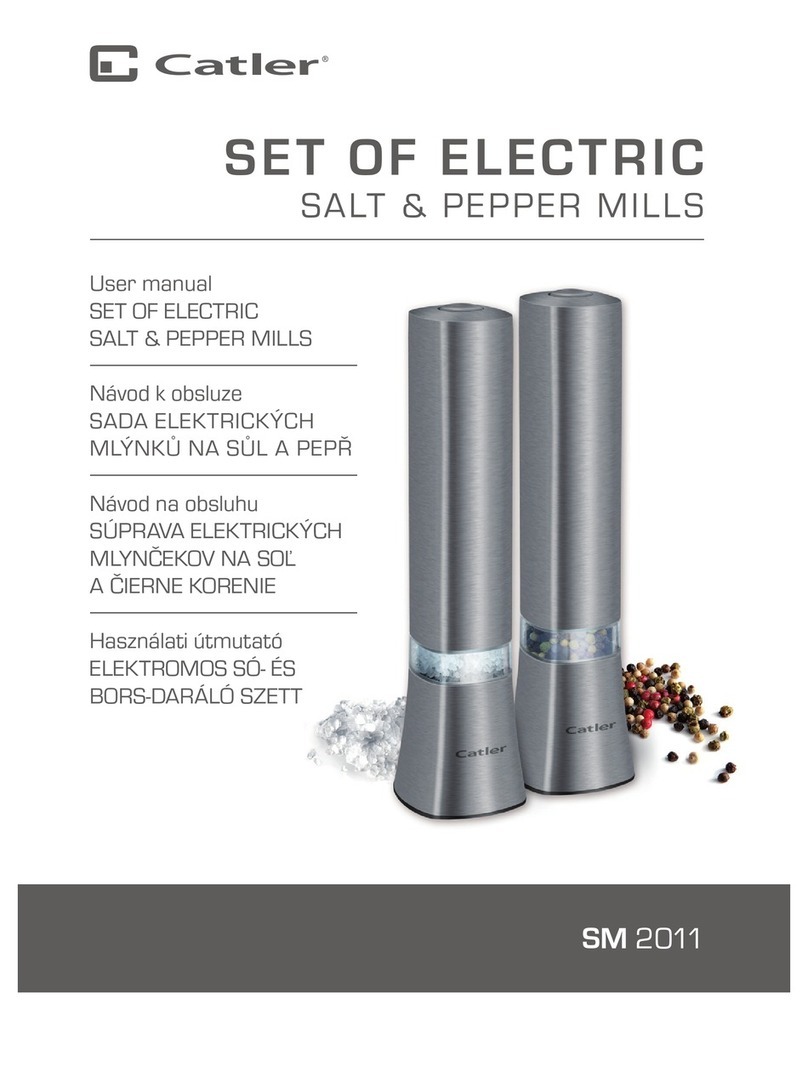
Catler
Catler SM 2011 User manual
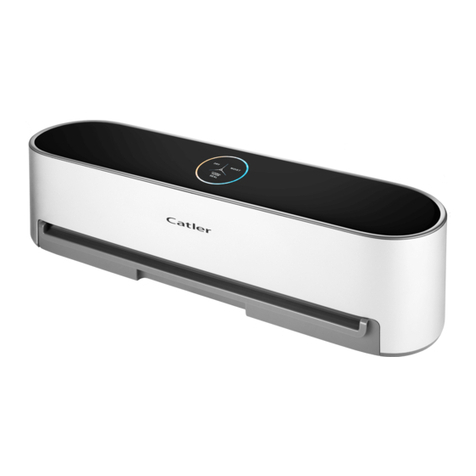
Catler
Catler VS 812 User manual
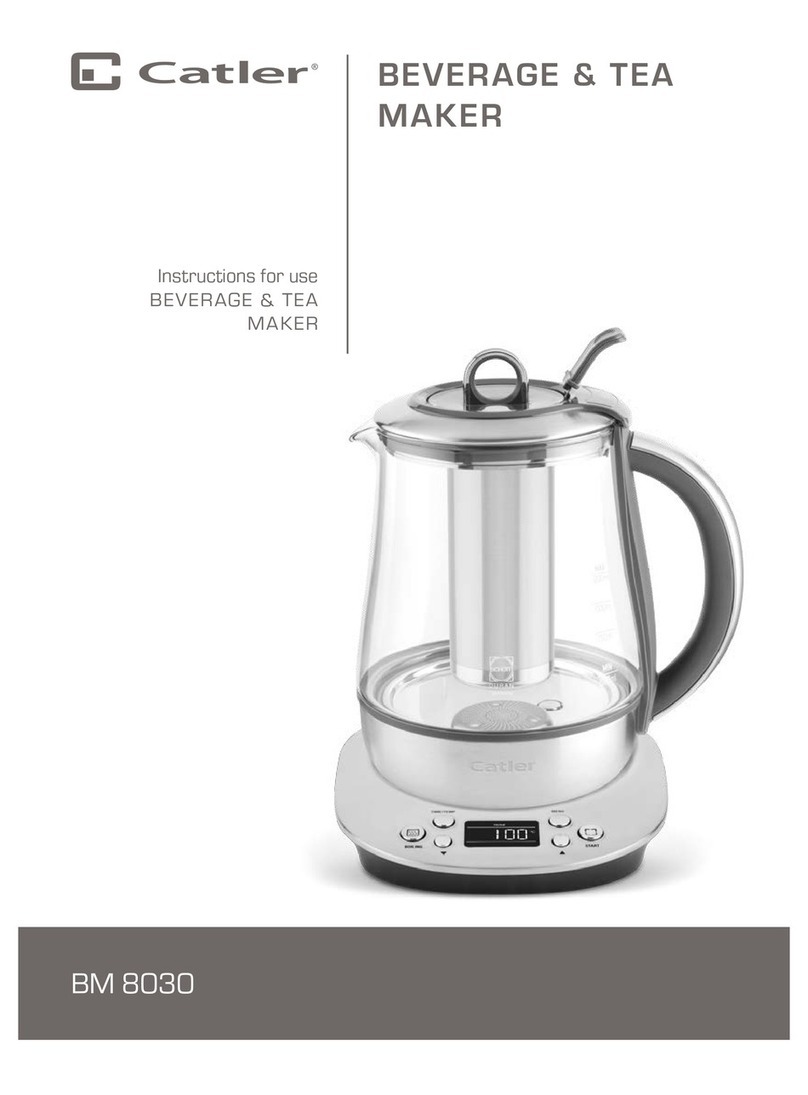
Catler
Catler BM 8030 User manual
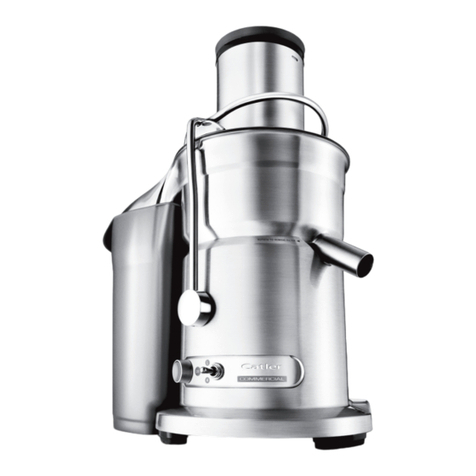
Catler
Catler 800 SERIES User manual

Catler
Catler MC 8010 User manual
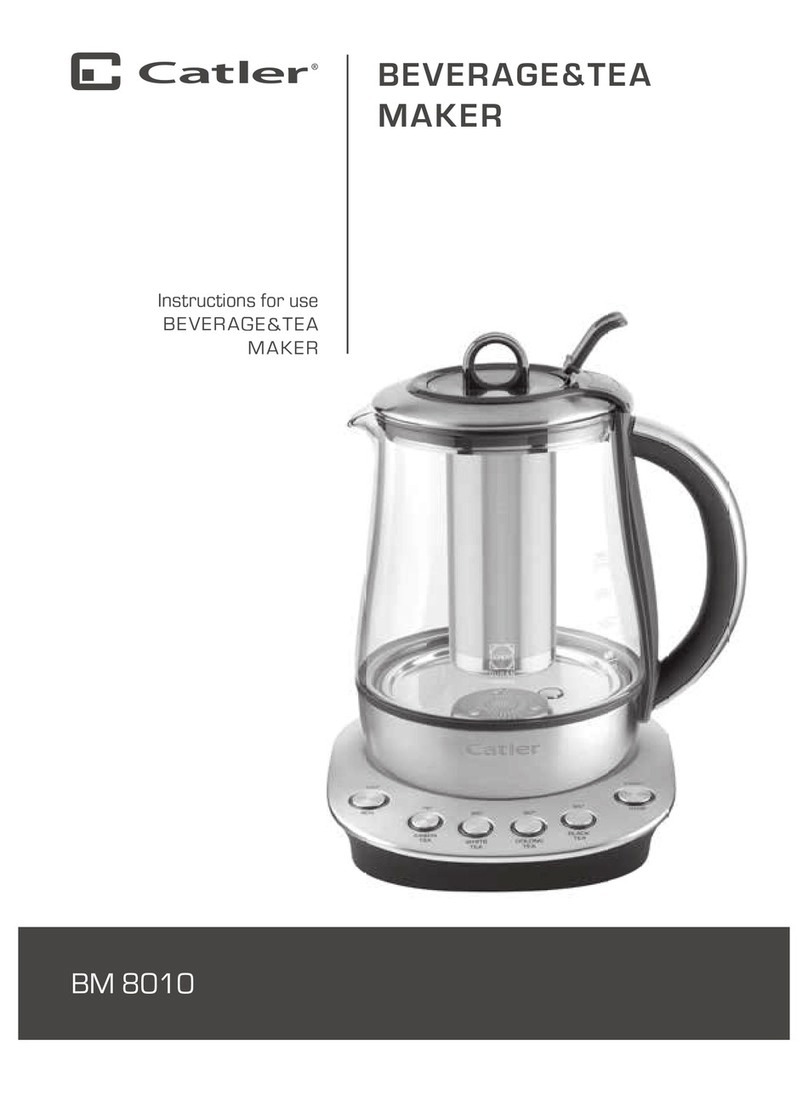
Catler
Catler BM 8010 User manual

Catler
Catler 800 SERIES User manual

Catler
Catler SP 8010 User manual
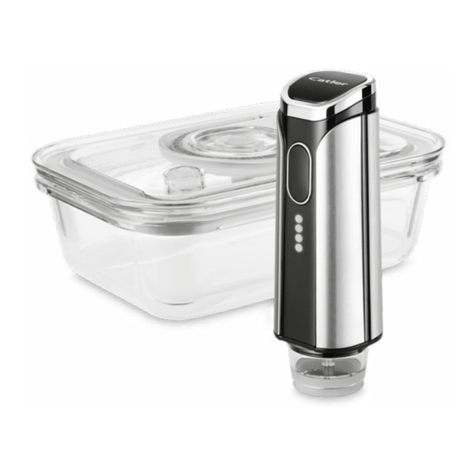
Catler
Catler VM 400 User manual

Catler
Catler FS 9010 User manual
